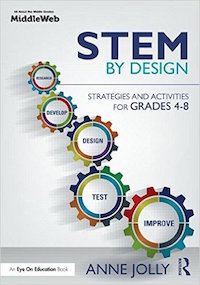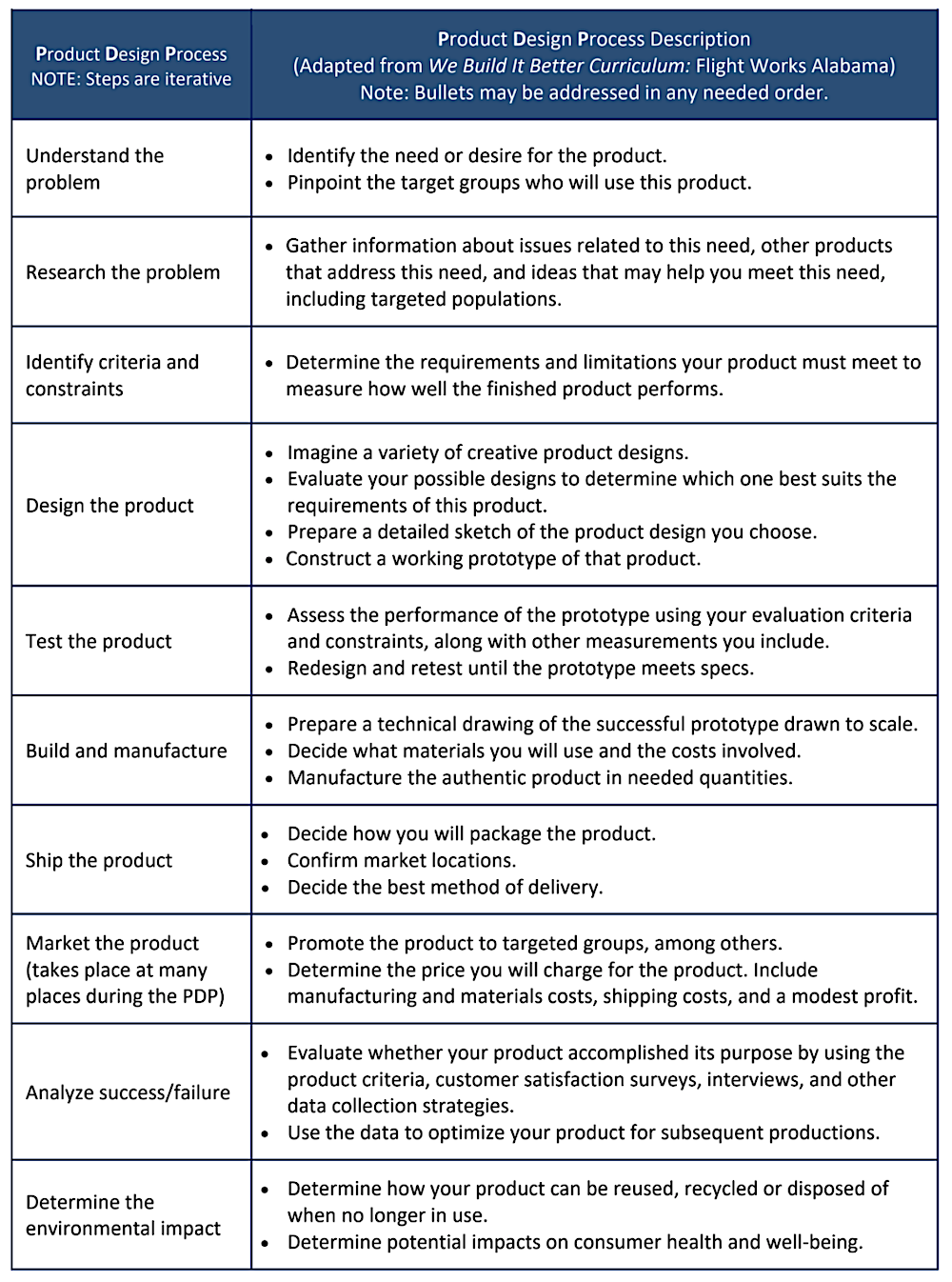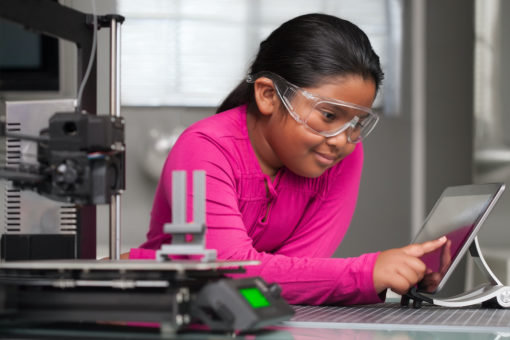Product Design Can Enrich STEM Projects
A MiddleWeb Blog

If you’ve read anything else I’ve written about STEM – here at MiddleWeb or in my book STEM By Design – you probably know that I always use the Engineering Design Process (EDP) as my “go to” guide for steering STEM lessons and projects.
Recently I joined a team developing a middle school workforce curriculum for Flight Works Alabama. As we work to create innovative experiences and introduce kids to new skill sets, I’ve had an “aha!” moment.
In this curriculum development program, we’re using an industry-based Product Design Process (PDP) and the overlap with the EDP is significant. For me, STEM nerd that I am, this overlap is reason to break into song and dance.
For one thing, it gives kids who have STEM backgrounds and are familiar with EDP a leg up if they happen to be doing some workforce-related projects.
Understand the problem? Check.
Research the problem? Check.
Identify criteria and constraints? Check.
Design the product. Check.
Test the product. Check.
You get the idea. The PDP will be nothing new for STEM kids – up to a point. But then new stuff kicks in.
Imagine you conduct a STEM project – and the solution for your STEM challenge winds up going beyond just a prototype. What if this prototype can become a product that kids make for actual use – even in a limited way? (With 3-D printers increasingly available, that’s a real possibility!)
The PDP gives students a way to think about taking their project solutions further. They can expand their thinking to include things like scaling up designs, manufacturing products, customers and marketing practices, distribution, environmental impacts, and so on. This sample PDP I designed will give you the big ideas. (If you want to try it with students, click the link to download it.)
Responding to real-world issues with doable products
You may be scratching your head at this suggestion since most STEM challenges focus on developing solutions for community or global issues, especially health and environmental problems. But if you think about it, some challenges do lead to a simple “product prototype” as a solution.
For example, maybe your kids have designed effective face masks to help prevent transmission of infectious diseases (see one idea here). The PDP steps provide an opportunity for them to develop a design more fully. Working through the steps of carrying an effective face mask from a prototype to a product can add a layer of mind-stretching information, skills, and vocabulary to their toolkits.
Suggest your students think of someone with a need they’d like to solve. Perhaps they know a person with arthritis who likes to sew but finds it painful to firmly hold a ruler in place and measure seams, hems, and fabrics. Your students might brainstorm and design an ergonomic hand grip this person could attach to the ruler he/she uses.
STEM teams could develop their designs and test prototypes. When they settle on a best design, they could start transforming that prototype into the real thing, using the PDP steps as a guideline. (A 3-D printer could easily “manufacture” a product like this.)
Ideas are certainly out there for this kind of STEM project expansion. Browsing some vetted STEM websites like Design Squad Global can yield product-worthy possibilities. My otherwise generous editor can be parsimonious with my word count, so I’m not going to delve into websites and lessons here, but you can find suggestions embedded in many of my MiddleWeb posts.
What’s not to like about this idea? And, did I mention that taking a STEM project through the product development phase begs for cross-curricular involvement? In fact, other subject areas and teachers become a necessary part of project success. Now, that’s a genuine school-wide STEM project!
New learning. New applications. New workforce skills.
Here are some thoughts about ways teachers can help kids carry their STEM project from prototype to product.
Students will need to . . .
Prepare technical drawings of the products. The math teacher can provide valuable assistance with scaling up the prototypes. Students can also use a free digital tool called Tinkercad to do their scaling and sketches – here’s a good spot for the technology teacher to step up.
Tinkercad introduces kids to a frequently needed workforce skill – computer aided design (CAD). As an added bonus, if you have access to a 3-D printer, students can 3-D print their products directly from Tinkercad. Talk about being immersed in current technology!
Know their customers. Who might be interested in their product and where are these people located? The social studies teacher could help with this kind of investigation. A language arts teacher might help students develop a professional-style interview or survey to find out whether this product is of any interest to this identified group(s) and what they might like the product to be able to do.
Manufacture their products. Kids will have to know what materials to use and how to actually make the product. (Remember that they need not make many finished products – they are likely limited by reality.)
Determine a delivery method. If they package and ship their products, they need to determine what packaging and shipping method they prefer.
Price their products. Math teachers might take on the task of helping kids price the cost of materials, packaging, and shipping costs. All of these, plus a modest profit, figure into the cost kids would charge customers.
Conduct a success analysis. Did the customers like the product? Students need to reach out to customers for feedback. The language arts teacher might again help them prepare surveys and interviews to gain information for improving their products.
Market their products. Art plays an important role in marketing. What kind of items can they design to market their product? It’s possible that art class students not connected with the original STEM project could take the lead in creating marketing materials. The marketing focus will also require skill in public speaking and interpersonal communication. Drama teachers and language arts teachers might be the chief coaches here.
Know potential impact their product could have on the environment. When your kids make prototypes, how often do they consider the environmental impact of the “real thing” they are proposing? If they’re going to make a handle that can be attached to a ruler, what’s it to be made of? How will it end its life? (Can it be recycled? Reused?) How will it affect the environment? Science teachers to the rescue!)
Taking the final prototypes beyond a conceptual level
Of course, your students aren’t likely to actually mass-market and sell their products, but experience in planning and doing some of that on a limited scale will reinforce their STEM foundation and their understanding of STEM careers.
So… if your STEM projects need an occasional boost, give your students a chance to take their final prototypes beyond a conceptual level. Imagine your students thinking: Can our design really be produced and used – even if we can make only a few? If I were a student, that would do it for me!
I understand that most STEM projects don’t lead to prototypes that fit into the “make it and use it” category. But when a project does – why not go for it?





































Thanks for this Anne! Really love the idea of teaching product marketing, through STEM concepts to younger audiences :-) These are core skills that can really be applied to any field.
Glad you think it will be useful, Kameel. I think it can add interest and purpose to their STEM projects. I appreciate your feedback.